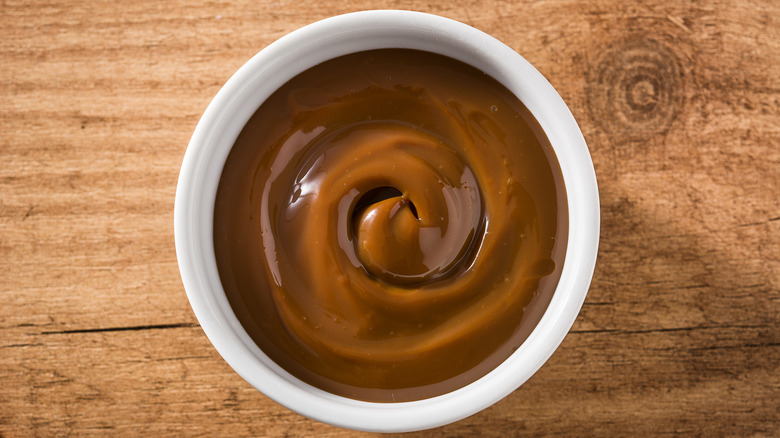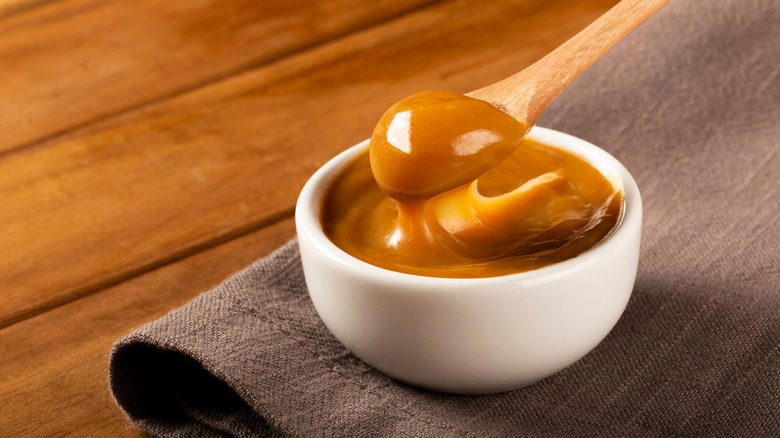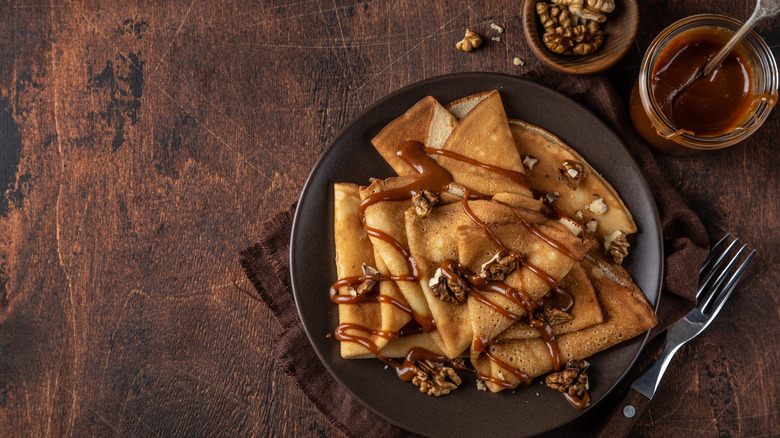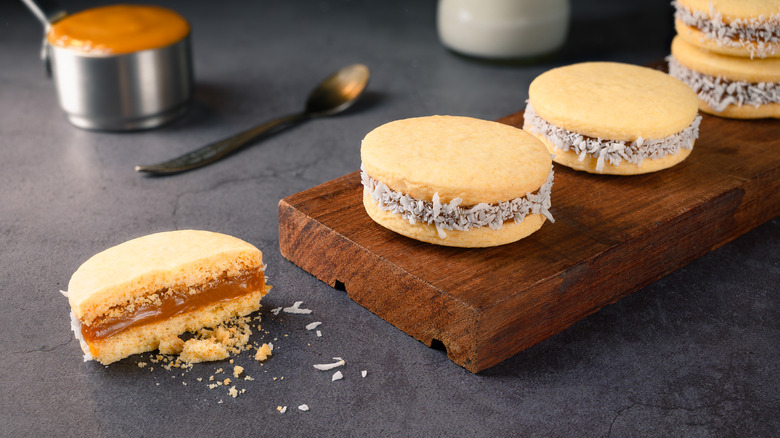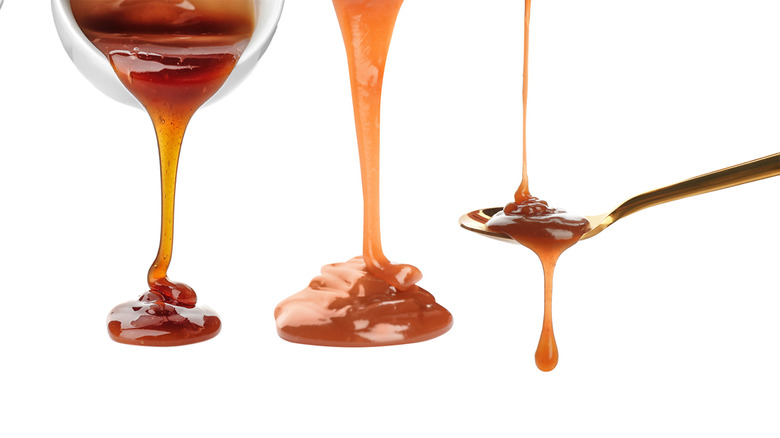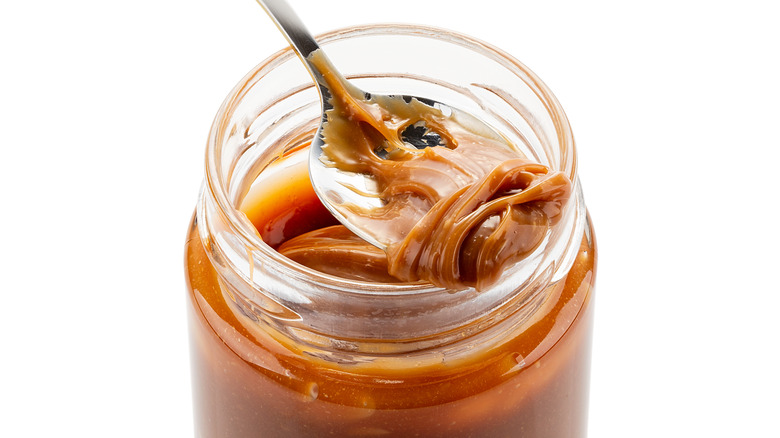The Untold Truth Of Dulce De Leche
We may receive a commission on purchases made from links.
Have you ever tried dulce de leche? If you were a kid in the '90s, your first brush with this type of soft Latin American caramel probably came in the form of a cone of Häagen-Dazs Dulce de Leche ice cream, which debuted in 1998 and brought the flavor to the attention — and palates — of a whole new audience.
"Dulce de leche" is translated from the Spanish to "sweet of milk," and is a smooth caramel made by slowly heating sweetened milk until its volume is reduced and its sugars concentrate into this wonder of a confection (via All Recipes). Popular all over Latin America, dulce de leche varies depending on what country it's made in, from Mexican cajeta, made with goat's milk, to Peruvian manjar, which sometimes includes a mind-altering touch of cannabis (via Alfajores Bakery). The caramel can be thick or thin, and can be served spread over toast, folded into crepes, or sandwiched between the butter cookies known as alfajores that are the pride and joy of Argentinian pastry kitchens (via The Spruce Eats). Read on to get to know this sweet treat.
Where does dulce de leche come from?
Widely known throughout Latin America, dulce de leche is typically associated with the cuisines of countries such as Colombia and Chile (via Alfajores Bakery). But where did the caramel originate? Like many food origin stories, the provenance of dulce de leche is shrouded in myth. According to historian Daniel Balmaceda, the milk sweet was traditional in Indonesia and was exported to the Philippines in the 16th century through trade between the two countries (via Culture Trip). When Spain colonized the Philippines in 1521, dulce de leche was then taken to Spain and then spread throughout Latin America as the country continued to colonize the southern hemisphere.
Some place the birth of dulce de leche a bit later. One European origin myth is that the candy was discovered in 1804 by Napoleon's cook, who was heating milk and sugar together only to leave it for too long, accidentally creating the scrumptious spread (via Culture Trip). Another popular theory places dulce de leche's birth squarely in Argentina, where some say Argentinian politician Juan Manuel de Rosa's maid mistakenly produced the sweet in the aforementioned manner, by forgetting about a hot pot of milk and sugar (via Alfajores Bakery). This legend corresponds with the first historical reference to dulce de leche, in an 1829 account of a meeting between de Rosa and a political enemy (via Martha Stewart).
How is dulce de leche used?
Wherever dulce de leche came from, countries across the world agree it's delicious, and make use of it in a variety of breakfast foods and desserts. Across South America, piononos jelly roll cakes feature a swirl of the sweet filling. Postre chajá, Uruguay's national cake, is constructed from layers of sponge, pillowy whipped cream, and generous slatherings of dulce de leche (via Martha Stewart). In Argentina, the popular rogel cake features 12 layers of crispy, buttery pastry spread with plenty of dulce de leche and topped with extravagant dollops of meringue (via Cook with Belula). And in various countries, including Venezuela, the Dominican Republic, and Puerto Rico, a version of dulce de leche is actually made with curdled milk and incorporated into dulce de leche cortada, a rich dessert fragrant with spices and studded with raisins (via The Cookware Geek).
Dulce de leche is now popular across the world and can be found sold in jars or cans in supermarkets. Therefore, it's also a common addition to more everyday items like toast, ice cream, and pancakes.
The alfajor: dulce de leche's best friend
No guide to dulce de leche would be complete without mentioning alfajores, the buttery shortbread cookies sandwiched with dulce de leche that are popular across South America, but something of a sensation in Argentina (via The Spruce Eats). According to Alfajores Bakery, the cookies originated in the Middle East at least as far back as the eighth century, where they were known as alajú, an Arabic word meaning "stuffed" or filled." The basic jam-spread cookies then traveled with the Moors to Spain, where locals adapted the recipe and renamed it alfajor. Alfajores landed in South America along with the Spanish conquistadors, where, over time, the cookie took its form as a sandwich filled with dulce de leche or marmalade.
The widespread popularity of alfajores can be traced to 1950s Argentina. It was there, in a tourist town called Mar de Plata, that local bakeries offered up the dulce de leche-filled treats (via Alfajores Bakery). Tourists visiting from across the country would take the cookies home as a gift for family and friends; eventually, copycat bakeries opened up across Argentina and around South America. Today, the Havanna bakery chain is perhaps the world's most famous producer of alfajores, shipping classic, chocolate-dipped, and walnut-studded versions worldwide (via Havanna).
How to make dulce de leche at home
While the process requires some patience, dulce de leche is thankfully pretty easy to make at home. To do so, whisk whole milk with sugar, bring it to a simmer, and cook over your burner's lowest setting, stirring occasionally and removing any foam from the top for about an hour. Using a heavy-bottomed saucepan will help keep the milk from scorching, and a little pinch of baking soda mixed into the milk helps speed up the cooking time. When the dulce de leche is done, it will be a deep golden brown and will coat the back of a spoon. After straining the sauce through a fine-meshed sieve, you can transfer it to an airtight container and store it in the fridge for up to two weeks (via Martha Stewart).
Another method for making homemade dulce de leche starts with a can of sweetened condensed milk. All you have to do is put the unopened can into a big pot, fill it with water, and bring to a slow boil for about two hours (via Martha Stewart). After cooling the can completely, you open it up and voila! You've got dulce de leche all ready to go.
How to pick out store bought dulce de leche
These days, most large supermarket chains like Walmart and Whole Foods will stock jarred dulce de leche; it's usually found in the baking aisle near the cans of sweetened condensed milk. Of the brands available, Nestlé's La Lechera Dulce de Leche, which comes in a can, is probably the most widely popular; common, too, is Eagle Brand Dulce de Leche, as well as a jarred version made by Bonne Maman, known for its fruit jams. But for as much as the uses for dulce de leche vary, so too does the quality of the brands available. So, how to pick out a delicious one?
You'll want to start by looking at the ingredients. Many packaged versions of dulce de leche contain unwanted additives such as pectin and sodium citrate (via Bake School); ideally, you'll want to find one that contains only milk and sugar. Your options will open up if you look past the grocery store shelf to your computer; online, you can purchase dulce de leche from specialty suppliers such as Argentinian options Havanna, San Ignacio, and Cachafaz. So get yourself a jar — or six — and thank Fate for all those forgotten pots of milk of yesteryear, which gave rise to this addictive sweet treat.
